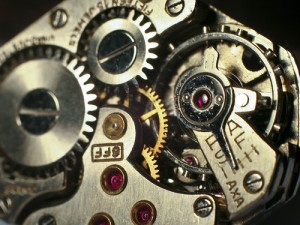Mechanical watches are sort of a big deal these days, for a lot of reasons, including the emerging popularity of steampunk crafts and the like. Spiffy looking pocket watches are turning into an “in” thing, and skeletonized wristwatches are becoming more and more popular. I figured I would set up a guide that would function as an intro, of sorts, to people who are new to this world, especially since a lot of folks I know around the ‘nets are looking into it.
DISCLAIMER: While I probably know more about this subject than most people in my typical friends’ circle, I’m still kind of a nub. Horology is a BIG topic. That said, let’s begin:
First off: how is a mechanical watch different from any other?
The vast majority of watches these days are “Quartz Watches”. They are powered by means of a battery and electrical pulses that are sent through a quartz crystal tuning fork, which resonates at a very steady frequency. This is then counted and “translated” into seconds– this is how the watch works. Because of their accuracy and low cost, Quartz watches became a big deal in the 70s and now that is most of what you see.
Mechanical watches are made the way they made them before the idea of Quartz watches existed. SUPER QUICK PHYSICS LESSON: A pendulum, if it does not lose any energy, will always swing at the exact same rate. This is where pendulum clocks came from. A watch does this by way of a spinning wheel called a balance wheel, which spins back and forth at a constant rate thanks to energy provided by way of the mainspring (and various other interesting mechanisms). A mechanical watch does not need a battery, although the mainspring will always need to be fed power by being wound up.
If you are unsure which your watch is: If it uses a battery and the second hand ticks exactly once a second: it’s probably a quartz. Mechanical watches (with few interesting exceptions) do not use battery power and most of them tick several times each second.
We good so far?
Okay. Moving on!
Some World History:
Lots of people all over the place made watches throughout the 18th century, but during the 19th century the British watchmaking industry all but died out for various reasons. Watchmaking continued in Switzerland (cause that is totally their thing), and in America. The United States produced a LOT of really high quality pocket watches throughout the 1800s and very early 1900s, as any vintage pocket watch collector would love to tell you all about.
Then the 20th century rolled around, and suddenly the United States was too busy dealing with various World Wars to continue much in the way of watchmaking. Leave it to good ol’ Switzerland, though, with their blissful neutrality, to pick up the slack. This is why today Swiss watches are a Big Deal (we’ll talk about this more in a bit).
When Quartz watches started showing up– cheaper and more accurate than traditional watches– the Swiss watchmaking industry, reluctant to let go of hundreds of years of tradition, was dealt a near-lethal blow. They were saved by Swatch and a guy named Nicolas Hayek, who died a few days ago, by the way *bows head*
ANYWAYS, they managed to float on that for a little while and then the “luxury” market for super expensive, super technical watches appeared and now you have mechanical watches making a comeback because we humans tend to be a nostalgic race. Spiffy, huh?
Now that I’ve told you all of this, we’ll move on to the real “meat” of the watch…
The Movement:
The movement is the name for the whole inside mechanism of a mechanical watch. Basically, if you take the case away, the movement is what is left.

Movements are exceptionally complicated pieces of engineering, largely because they are so very small. Most watchmakers have to go to school for a few years before they can even think about building their own. The reason I am telling you this is because if you see a watch being sold on Etsy or some other craft site, I can guarantee that the movement itself was not made by the crafter. Rather, the crafter ordered the movement from somewhere else, and then modded up a spiffy case for it.
Independent watchmakers, who build their own watches from the ground up, do exist, but they invariably spend about a year on each watch and then sell them for tens of thousands of dollars. (You would, too, if you were building one thing a year as your profession.)
This is why it is important to be aware of the various types of movements and their quality when you are buying a mechanical watch. For example:
Swiss Movements: These guys have been doing this for centuries. They know what they’re doing. For the most part you are going to get solid and reliable performance. The downside is that they tend to be expensive, and the more complications you add to your watch or the more reliability you want, the pricier it’s gonna get.
Swiss movements are considered by most watch aficionados to be “the real deal” and watches that have them will say they do, right on the dial. It’s like having a super expensive brand name car or something.
Japanese Movements: Lack the “prestige” factor of Swiss but are also pretty solid.
Chinese Movements: China is the other big producer of watch movements right now. They’re still kind of learning but they’ve got some really good stuff if you know where to look. The main thing to look out for is the cheaper and super-mass-produced Chinese Movements. If your mechanical watch was dirt cheap (i.e. one of those $1 ones on eBay), it’s probably got one of these. In that case it’s sort of a grab bag box-of-chocolates… you never know what you’re gonna get. You might get something good or you might get something that breaks in a few weeks. You never know.
That is just the super condensed version of it. The whole movements story and what it means is pretty multi-layered. The main thing to get out of this is that, for the most part, you get what you pay for.
The Care and Feeding of Your New Mechanical Watch:

So you decided to buy one. Awesome! Doesn’t it make a lovely ticking noise? <3 Here are a few things to be aware of if this is your first: 1.) At first, it is probably going to run fast. It might run very fast. You might be worried because two days after getting your new watch you already have to reset the time. Don’t panic. New watches tend to run fast because the lubrication has yet to spread throughout the springs. Give it a bit of time.
2.) Store your watch in different positions. This will help a lot in the beginning, especially, with helping to get that oil going. Take your watch off when you go to bed and let it sit overnight upside down, right side up, crown up, crown down… just in a different position every night. This does wonders for the accuracy of the watch. (At least, it did with mine, which went down from +15 seconds a day to probably +5. Which is pretty dang good for an entry-level mechanical.)
3.) Get it serviced every 3-5 years. Your watch is a machine that is constantly working 24/7. It has lubricants that are going to dry up and these need to be reapplied every so often.
4.) Be careful – mechanicals are tough but they can’t take a ton of abuse. You might want to take it off if you’re doing some extreme sport or something. (Unless you have one of those watches that they made specifically for said purpose.)
Pike, I didn’t need that whole entire ramble. I just want something pretty!
Search Etsy or eBay for mechanical “steampunk” style pocket watches. A really big selection is going to turn up. These watches will do very nicely for a costume or to simply look gorgeous. They may not have staggering accuracy and they may not last for decades, but they will work decently enough and will certainly fill the bill that you want!
Pike, I didn’t need that whole entire ramble. I just want something accurate that tells the time!
Get a quartz watch; they are cheaper and very, very accurate. They make quartz pocket watches now, too. I even have one! *nod*
Or, you know, just check your cell phone for the time… but that’s not as fun, now, is it? Is it??
Pike, I want something that is pretty, is going to last a while, and is memorizing to watch (no pun intended).
Then, my friend, you have come to the right place. It’s hard to explain all the charming little idiosyncrasies of a mechanical watch without actually owning one, so you’ll just have to try it out. I don’t know, but to me there is something delightful about the noises it makes when I turn my wrist, or the shifting weight of the spinning rotor when I move my arm, or the way you can sometimes unexpectedly hear the ticking noise if you’ve got the watch tilted and your ear tilted juuuust right. Throughout the day, the watch gives you little reminders like that– that it is still there– and as dorky as it sounds, you don’t feel quite so alone. :3
YES I AM A NERD, SHUT UP.
*coughs*
